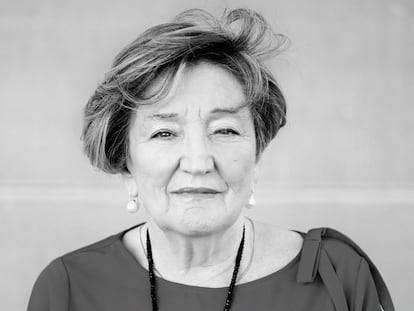Patients with endometriosis have gone more than 20 years without new treatments
The causes of the disease are still unknown, although it affects 190 million women in the world


Four years ago, Marina Bonache began to suffer severe pain during her periods. Her gynecologist told her that everything was fine. Her hormone levels were normal and nothing showed up on ultrasounds. But she did not settle for that answer. She kept looking. Two years later, when she was 25, another doctor gave her problem a name: endometriosis. It is a chronic pathology in which endometrial tissue grows outside the uterus.
According to Emanuela Spagnolo, from the Spanish Society of Gynecology and Obstetrics (SEGO), it is estimated that in Spain between 10% and 15% of women suffer from this disease, which takes an average of seven years to diagnose. Raúl Gómez, who studies endometriosis and endometrial cancer therapies at Spain’s Health Research Institute (Incliva), laments that for the last 25 years, “the same strategies [generally hormonal therapy] have been used, with slight variations, inherited from the latest studies carried out on patients.” The researcher attributes this to the fact that historically, research on the disease has been focused on knowing how it worked, what the lesions were like and what factors were involved, but not about the pain it brings. “Endometriosis has always existed, but it has received little visiblility and recognition,” Gómez adds.
Some 190 million women suffer from this problem worldwide, according to the WHO. In this disease, the endometrium, which is the tissue that lines the inside of the uterus, is found outside the uterine cavity. When the woman undergoes menstrual changes, the tissue spreads, producing cyclical bleeding in these areas without the blood exiting the body. The ailment can cause menstrual cramps, excessive bleeding, abdominal pain (which can sometimes be disabling), problems having children and infertility. It is diagnosed by ultrasound or laparoscopy (a minimally invasive surgery), but Gómez acknowledges that it is difficult to identify when it is in an early stage. Although the prevalence of the disease is high, no one knows what causes it. “It is known that immunological and genetic factors are involved, but the cause is still unknown,” sums up Spagnolo, an associate at the endometriosis unit at the Hospital de la Paz in Madrid.
In order to live with the disease, Bonache follows a hormonal treatment based on antiestrogens, which reduce the levels of estradiol, the hormone that causes the proliferation of endometriosis, Gómez explains. The problem with these drugs is that they end up inducing “a pseudomenopause that can cause symptoms such as hot flashes, hormonal imbalances and the beginning of osteoporosis,” says the expert. Other options are surgery, anti-inflammatories and opioid analgesics, the last two in mild cases.
Non-surgical treatments
Between 10% and 15% of women who undergo conservative surgery (without removing the uterus) suffer from the disease again one year later, a figure that rises to 40% and 50% after five years, according to a study published last November. Now there is a tendency to limit surgical interventions to very specific cases: “It has to be carried out in highly specialized endometriosis centers by professionals from various specialties,” says Silvia Iniesta, a member of SEGO and a specialist at the Hospital de la Paz in Madrid.

Bonache has been able to control most symptoms with medication, although she suffers from dyspareunia (painful sexual intercourse) and has difficulties urinating. The young woman, who is now 27 years old, came to spend three weeks in bed, “without tolerating even water because of vomiting and pain.” She suffers from peritoneal endometriosis and adenomyosis (the name it gets when it’s in the womb). Bonache had to leave her job due to her condition. “I am a nurse, and in my hospital they told me that they could not adapt the position to me because my illness was not serious enough.”
For her, the hardest part of the disease is having to lead a life “measured down to the millimeter.” Even so, she doesn’t have control of her own body. She must sleep enough hours, exercise, but not excessively, and she cannot skip her medication. She must also follow a low-estrogen diet and visit a physiotherapist and psychologist to better deal with the symptoms of her ailment. And she wants to be a mother, but she has to have everything planned.
Between 30% and 35% of women with fertility problems suffer from endometriosis, says Spagnolo. This condition causes the ovaries to function less well and, in many cases, leads to a low ovarian reserve. All women can see their fertility reduced from the age of 30, but in the case of patients with this pathology, age implies an even greater risk for those who want to have children.
What helps Bonache to cope with her situation is, in addition to the support of her family and her partner, “following people on Instagram who suffer the same thing, seeing people who are the same as me,” and the support of the Association of Endometriosis Patients of Catalonia (Endocat). Talking with other patients has helped her a lot, she says, in being able to manage the disease and in feeling fully understood. In addition, there is the State Association of Affected by Endometriosis (ADAEC), which offers advice, the young woman adds.
Searching for a solution
One of the current goals of experts is the early detection of this disease, says Spagnolo. The La Paz Hospital, where she works, is developing a project, together with European universities, to identify the condition in adolescents. They also intend to train primary care professionals and more gynecologists “so that the diagnosis does not arrive when the patients are older,” she says. “Detecting it in its early stages and treating it from the outset improves the quality of life of those who suffer from it, because the pain and duration of the problem will be less,” adds Gómez.
Other researchers focus on finding the origin of the ailment. A study published in Nature Genetics last week includes results from scientists who created an “endometriosis cell atlas” with samples from 21 patients, according to its lead author, Kate Lawrenson. The researchers hope this finding will help them better understand “the origins, natural progression, and potential therapeutic targets for treatment,” says the scientist and associate professor at Cedars-Sinai’s Department of Obstetrics and Gynecology.
Regarding treatment, although alternatives to hormones are being sought, none have yet given results. Last November, a study was published in which a natural component found in olive leaves, oleuropein, had been used to treat endometriosis in mice. This substance slowed the growth of lesions caused by the ailment, according to the study, published in the Journal of Biomedical Science, but it could not be determined whether it reduced pain, explains Sang Jun Han, one of the authors and a researcher at the Department of Molecular and Cellular Biology at the Baylor College of Medicine (Houston, USA).
Gómez is skeptical about translating the results of this research to humans. “Mice do not have endometrium and are incapable of developing the disease naturally,” he explains. It must be induced by artificially creating the tissue or implanting lesions in these animals, something that does not fully reflect the real situation, the expert adds. For Gómez, the future of research should focus on these alternatives because “an anti-estrogenic treatment is incompatible with the natural fertility of the patient,” he explains. Spagnolo raises the possibility that alternatives serve only certain patients, since “the hormonal factor is the main cause of the disease.”
Sign up for our weekly newsletter to get more English-language news coverage from EL PAÍS USA Edition
Tu suscripción se está usando en otro dispositivo
¿Quieres añadir otro usuario a tu suscripción?
Si continúas leyendo en este dispositivo, no se podrá leer en el otro.
FlechaTu suscripción se está usando en otro dispositivo y solo puedes acceder a EL PAÍS desde un dispositivo a la vez.
Si quieres compartir tu cuenta, cambia tu suscripción a la modalidad Premium, así podrás añadir otro usuario. Cada uno accederá con su propia cuenta de email, lo que os permitirá personalizar vuestra experiencia en EL PAÍS.
¿Tienes una suscripción de empresa? Accede aquí para contratar más cuentas.
En el caso de no saber quién está usando tu cuenta, te recomendamos cambiar tu contraseña aquí.
Si decides continuar compartiendo tu cuenta, este mensaje se mostrará en tu dispositivo y en el de la otra persona que está usando tu cuenta de forma indefinida, afectando a tu experiencia de lectura. Puedes consultar aquí los términos y condiciones de la suscripción digital.
More information
Últimas noticias
Most viewed
- Reinhard Genzel, Nobel laureate in physics: ‘One-minute videos will never give you the truth’
- Oona Chaplin: ‘I told James Cameron that I was living in a treehouse and starting a permaculture project with a friend’
- Pablo Escobar’s hippos: A serious environmental problem, 40 years on
- Charles Dubouloz, mountaineering star, retires at 36 with a farewell tour inspired by Walter Bonatti
- Why we lost the habit of sleeping in two segments and how that changed our sense of time










































